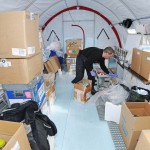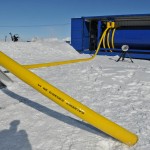The clear-up begins
Final word from Programme Manager
This is clearly a very disappointing time for the team who are now busy draining down the systems and preparing all the cargo for uplift – not an insignificant task. However, whilst the field season did not turn out the way we had planned, there are a number of valuable lessons we can learn from this experience which will contribute to the collective, global knowledge in hot water drilling.
The consortium will now regroup and take stock of the situation. There are lessons to be learned and there is equipment to be serviced. The fundamental science questions raised by the programme remain viable, interesting and unanswered and the consortium will be preparing plans to revisit the exploration of subglacial Lake Ellsworth at some point in the future.
So keep watching. This is not over yet!
Finally, we would like to acknowledge everyone for the tremendous support and encouragement we have received. I know you will be as disappointed as we are about this outcome, but the enthusiasm with which you have followed our progress has been extremely uplifting for us. On behalf of the field team and the wider consortium I would like to say “thank you”. We wish you all the very best for a happy and successful 2013.
Chris Hill
Subglacial Lake Ellsworth Programme Manager
A hard decision
Fine margins
Final message from the ice
Mission update from Principal Investigator
In the early hours of Christmas Day (Tuesday 25 December 2012) Professor Martin Siegert, Principal Investigator of the Subglacial Lake Ellsworth experiment, confirmed that the mission to drill into the lake has been called off for this Antarctic season. Drilling was proceeding well during the weekend after a replacement part was fitted to the boiler used to heat water for drilling.
Drilling stopped after the team was unable to form properly the water-filled cavity 300 metres beneath the ice. This cavity was to link the main borehole with a secondary borehole used to recirculate drilling water back to the surface.
Martin said “On Christmas Eve we took the decision to cease our efforts to directly measure and sample Subglacial Lake Ellsworth. Although circumstances have not worked out as we would have wished, I am confident that through the huge efforts of the field team, and our colleagues in the UK, we have done as much as we possibly could have done, and I sincerely thank them all. I am also hugely grateful to the UK Natural Environment Research Council for making it possible for us to attempt the direct exploration of subglacial Antarctica. Sixteen years ago, we hypothesised that deep-water subglacial lakes are viable habitats for life, and contain important records of ice and climate history. For now, these hypotheses remain untested. Once back in the UK I will gather our consortium to seek ways in which our research efforts may continue. I remain confident that we will unlock the secrets of Lake Ellsworth in coming seasons.”
The first borehole was drilled to a depth of 300m and then left at that depth for 12 hours to create the cavity. The second, main borehole (located 2m away from the first) was then drilled to 300m depth and should have immediately connected with this cavity. This main borehole would then continue through the cavity and down to the lake while the first borehole would be used to recirculate water back to the surface using a submersible pump. In this way, the ice cavity can be used to balance the level of water in the boreholes and hence balance the pressure from the lake upon breakthrough.
For reasons that are yet to be determined the team could not establish a link between the two boreholes at 300m depth, despite trying for over 20 hours. During this process, hot water seeped into the porous surface layers of ice and was lost. The team attempted to replenish this water loss by digging and melting more snow, but their efforts could not compensate. The additional time taken to attempt to establish the cavity link significantly depleted the fuel stocks to such a level as to render the remaining operation unviable. Reluctantly the team had no option but to discontinue the programme for this season.
Professor Siegert continues, “This is of course, hugely frustrating for us, but we have learned a lot this year. By the end the equipment was working well, and much of it has now been fully field tested. A full report on the field season will be compiled when the engineers and programme manager return to UK.”
Thank you to everyone for your continued support over the past few weeks, which has meant a great deal to all the team working on this amazing project, especially the 12 men on the ice in Antarctica. Over the next week we will upload some more videos and images of our activities from the past few days so you can see how we were getting on over the Christmas period. We hope you all had a fantastic Christmas and all the best for the new year.
Christmas message from Lake Ellsworth
Dominic talks sediments
Snow management















